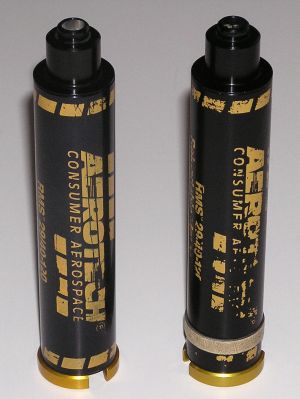| Manufacturer: | Aerotech  |

Brief:
The AeroTech 29MM RMS is a reloadable motor casing for mid-power flights with
"E" through "G" power reloads. This is a system that allows
the flier to put their own motors together with the power requirements to suit
their rockets power capabilities. AeroTech calls this their hobby loads and no
special certification is needed to use this system.
Construction:
The main components are the forward closure, the main body tube, and the aft
closure. All components are made of high quality aluminum that have been
machined to exact dimensions then hard anodized for long wear and color. Each
RMS is date coded and serialized for identification.
The construction for each of the reloads is fully explained in the reload package and basically follows the same procedure for the various sizes.
The most important thing is to follow those instructions exactly and keep everything clean! This is serious stuff in a fun hobby and you need to concentrate on what needs to be done step by step. Failure to do so will result in a failure of the motor and damage to your rocket or worse. However, this is also a very satisfying part of rocketry in that you are the one building the motor that sends your beautiful bird high in the sky with perfect recovery.
The actual motor build is quite quick and very easy to do. My two cents on the subject is to do it in a controlled area, like your build bench at home where you can keep everything clean. Clean is very important! Any piece of dirt or hair that gets on the O-rings can prevent them from sealing properly and will cause a seal failure. Outside at the launch area there can be anything blowing around or people distracting you. Either of which can cause problems.
I build my reloads at home the day before, but I don't install the ejection charges until I get to the launch site. This way I know it was put together right and if I need to take it apart for any reason, the ejection charge will not get loose and cause a problem later. The ejection charges are very simple to install in the field. Plus, since they are in a red cap, you can easily see if you have put them on the RMS or not when ready for flight.
As far as a grease goes once the supplied type is used up, there are many choices. I personally use good old Vaseline! Just keep in mind that all you are trying to do is put a very slight film of lube on the O-rings. They should have a slight shine to them and no more. No lumps, clumps, or splotches on the rings. In this case, less is more. I also use Vaseline inside the motor case and forward closure to allow for easier cleanup. Again, a very light coating on the inside just to allow the motor components to slide out easily when it is time to clean out the case. If the grease rolls up on the edge of the grain case or the delay charge when you install it, it will squish out onto one or both and they will not operate correctly. This is why you need to be careful and focused on what you are doing.
No special tools are needed to do all of this except for anything you may use to remove the spent motor. Use only items that are softer than the alumium or you will badly scatch the case, possibly damaging it beyond future use. I use plastic tools of various sizes and shapes to push or scrape as needed.
Finishing:
There is no finishing of the RMS as it is already done. As you can see, one of
mine is very used and the finish has been messed up a bit. This is strictly
cosmetic and is not a problem for use. Just remember to pull your motor hook
away from the motor when you remove it and the case will stay pretty for a long
time.
Flight:
PROs: Easy system to use. Can save a large amount of money over single use
motors. You use the same case over and over. Very satisfying to see a motor you
built yourself perform as planed on a perfect rocket flight. Very versatile
system on motor power requirements. One case with multiple engine sizes
available.
CONs: Must be very careful when assembling! Sometimes very difficult to clean out the spent engine. Initial cost higher to start.
Recovery:
The only issue on recovery is that you do get it back. If you are careless and
the rocket spits the motor, not only are you out a large investment but the
case is much heavier and can cause damage on landing.
Summary:
I use both single use and reloads in my rockets and really like the fact that
one case can be used over and over with so many different power factors. As far
as the failures that have been mentioned here, I have had none in all my
flights and the product is safe and fun to use if it is assembled carefully and
correctly.
Overall Rating: 5 out of 5
Other Reviews
- Aerotech 29mm RMS Motor By Alex Rothchild
This is a 29mm aluminum motor casing, for motors with 40-120 Newton Seconds total impulse (ranging from E to G). It is a bit pricey at $50 for the casing, but a G motor costs only $10-12 instead of $20 or more for a single use motor of the same total impulse. The casing is only three pieces, a long casing, a forward closure, and an aft closure, both of which screw into place in the casing. ...
 |
 |
 |
 |
J.L. (December 23, 2006)